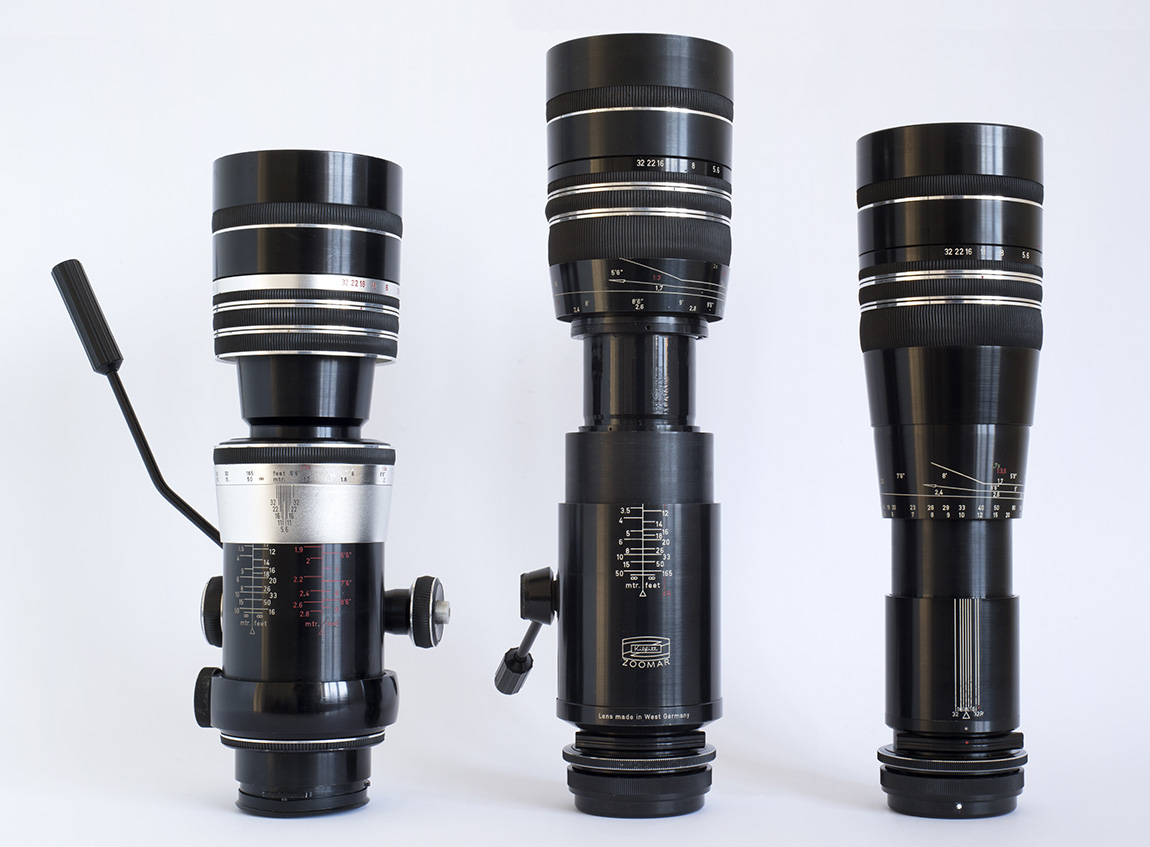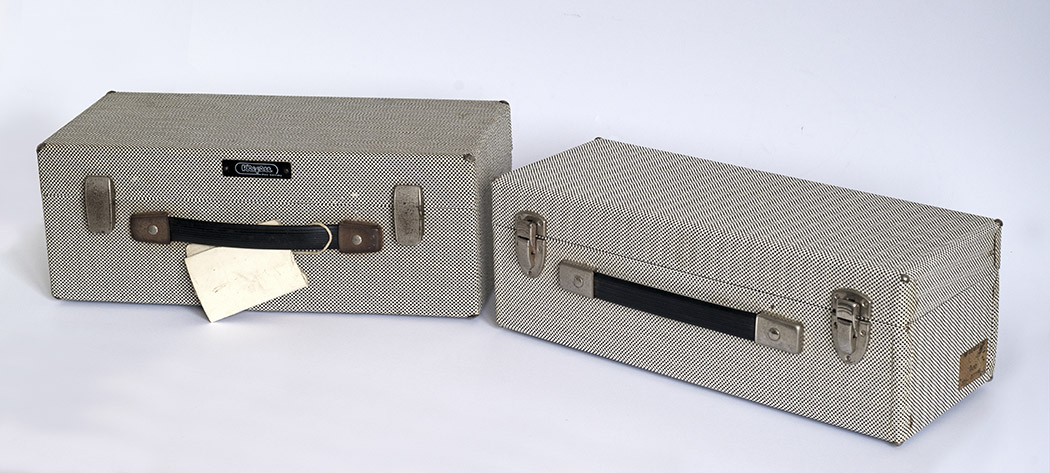by TRA
Pentacon Six Lenses
The
Kilfitt/Zoomar Pan-Tele Kilar Versions 1 – 3
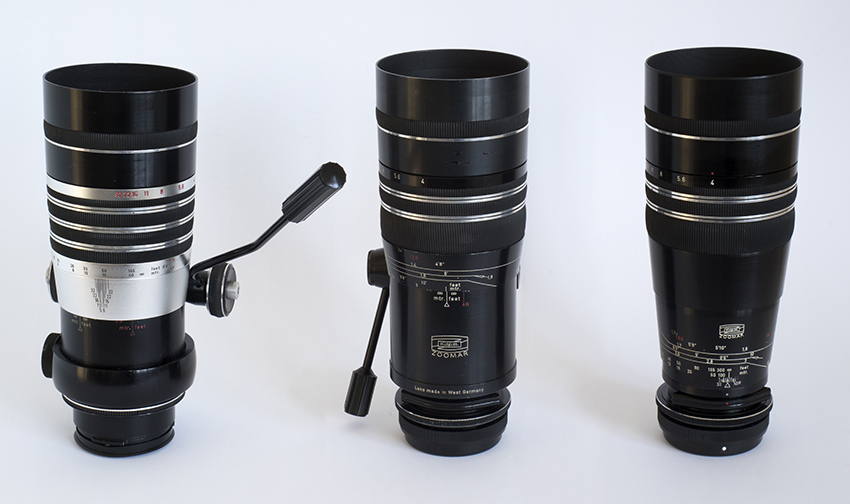
The three versions of
the 300mm f/4 Kilfitt Pan-Tele Kilar lens
Clicking on this image opens a larger
copy.
[PTK_I-III_02s.jpg]
One of the most highly-rated of the
Kilfitt lenses was the Pan-Tele Kilar. It is
described in detail here.
Three versions of this lens were produced,
and of course mounts were available for almost all makes
of Medium Format, 35mm and ciné cameras.
| An excellent source
of information on the Pan-Tele Kilar – and indeed
on Kilfitt/Zoomar in general – is
Patrice-Hervé Pont’s “Kilfitt Zoomar Imageurs et
Objectifs”, published by the French Club Niépce
Lumière, and some information on this page is
taken from that book. |
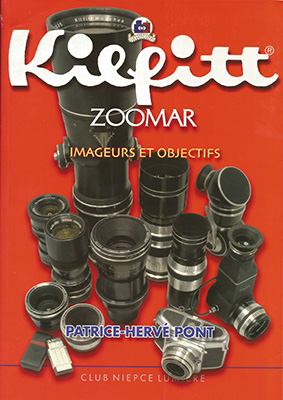 [kilfittbk.jpg] |
Version 1
Pont states that version 1 of the
Pan-Tele Kilar was available from approximately 1957 and
until 1966. It is the version that is described
and illustrated in detail on this website, here.
|
The manufacturer’s code name for
this version was PANTE and Pont reports that the
serial number prefix was 250, which is confirmed
in the case of the lens that I have. For
more on Kilfitt serial numbers, see here, near
the bottom of the page. The camera mount system base that
I have seen consists of the AN base, and Pont
says that the lens was also available with the
KI base, which was essentially for 35mm cameras
and smaller. On the base section of the
lens mounts, see here. The lens name ring has “Heinz
Kilfitt München” and “Pan – Tele – Kilar”.
(Obviously, the non-red text on the lens name
ring is in white.) A rotatable ring on the lens
gives the exposure compensation factors for
different focussing distances. This is
designed as an aid to the photographer when
choosing the correct exposure. Turning
this ring does not change any settings on the
lens. |
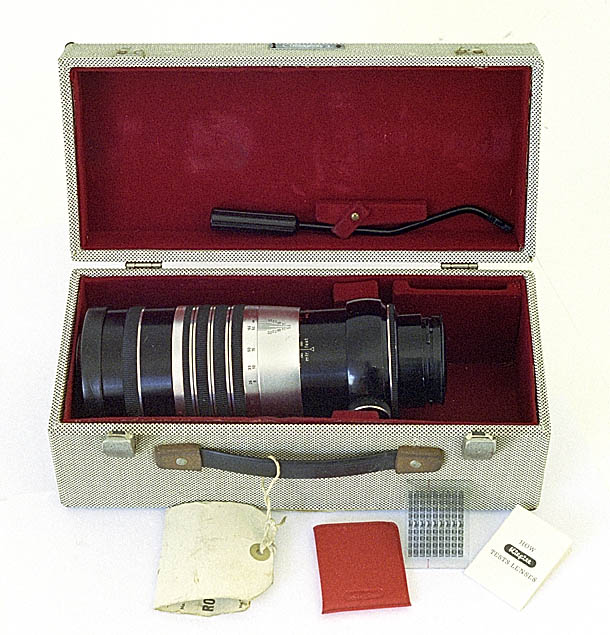 Pan-Tele Kilar Mark I [C475_35A.jpg] |
Version 2
The lens name ring has
“ZOOMAR MUENCHEN” and “Pan – Tele – Kilar” (all in
white lettering).
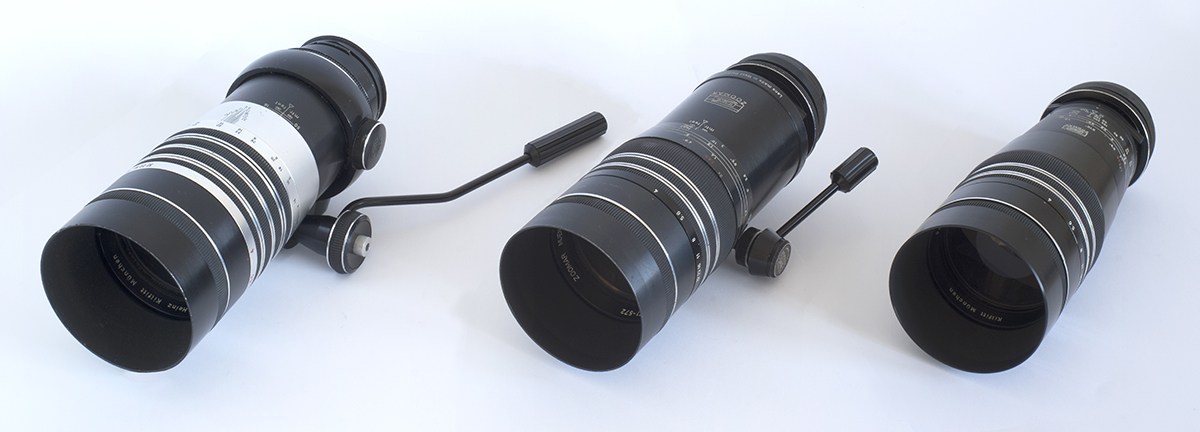 Pan-Tele Kilar From L to R: Versions 1 – III Clicking on this image opens a larger copy. [PTK_I-III_01s.jpg] |
||
| Pont states that version 2 of the
Pan-Tele Kilar was available from 1966 to
1979. So when version 2 entered
production, version 1 ceased production. The manufacturer’s code name for this version was PANSO and Pont reports that the serial number prefix was 271, which is confirmed in the case of the lens that I have. This version has an all-black finish. The camera mount system base that I have seen consists of the WE base, which is confirmed by Pont. The second version of the PTK retains the two focussing mechanisms of the first version:
Version 2 focusses closer than Version 1. (See data below) Focussing distances, exposure compensation factors and image ratio are recorded on the focussing ring of the lens, in the style seen on the Makro Kilar (see here). The helical focussing ring locks, or clicks, in the infinity position, which prevents it from being turned inadvertently when using the rectilinear focus. Its WE base mount includes a slot for a filter, which is not present on the AN mount on Version 1 of the lens. The version 2 Pan-Tele Kilar that I have came without the original wooden box. The overall diameter if the main section of the barrel is slightly smaller than in the first version, so the lens fits comfortably in the box in which version 1 was supplied, with a little bit of spare space at each side, plus the usual space at the back end for a mount for a 35mm camera. |
Version 3
Unexpectedly, the lens name ring has the
legend “Kilfitt München”, as well as “Pan – Tele –
Kilar” (all in white lettering).
Pont states that version 3 of the Pan-Tele Kilar was available from approximately 1966 and until approximately 1977. This version was thus available at the same time as version 2, over most of the years that version 2 was available, as an alternative form of the Pan-Tele Kilar.
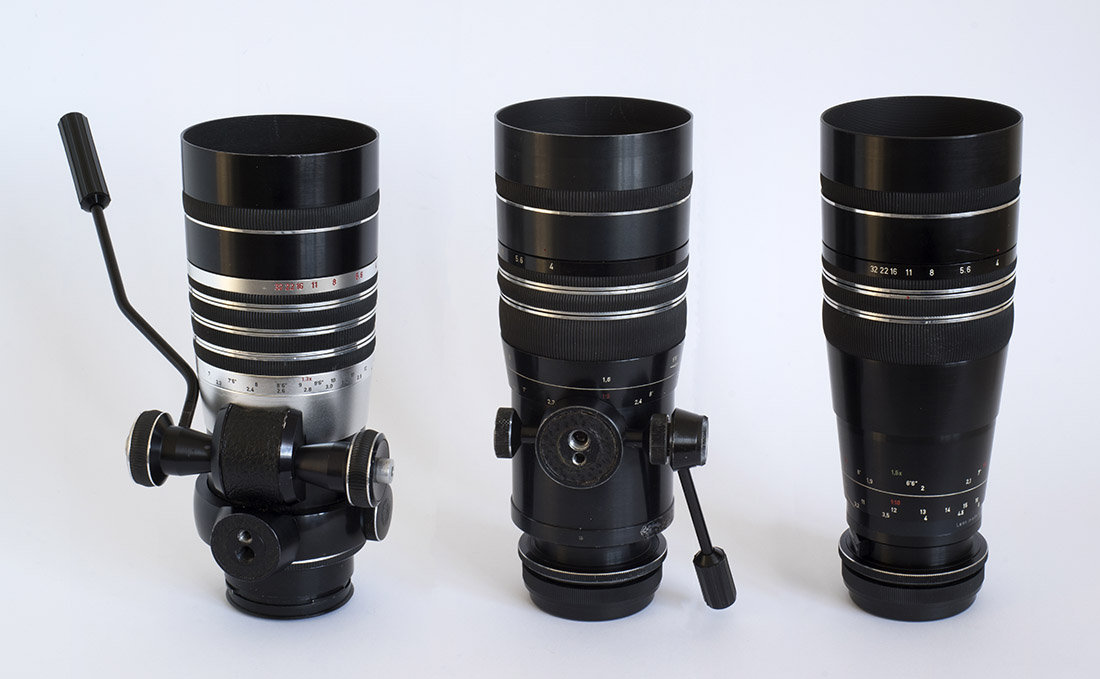 The underside of Pan-Tele Kilar Versions 1 – III Clicking on this image opens a larger copy. [PTK_I-III_03s.jpg] |
||||||||||||||||||||||||||||||||
| The
manufacturer’s code name for this version was PANO
and Pont reports that the serial number prefix was
also 271 with this version, which is confirmed
in the case of the lens that I have. Like version 2, version 3 is all in black. As with Version 2, the focussing distances, exposure compensation factors and image ratio are recorded on the focussing ring of the lens, in the style seen on the Makro Kilar (see here). The camera mount system base that I have seen consists of the WE base, which is confirmed by Pont. It is clear that Kilfitt/Zoomar had three aims in producing this version of the Pan-Tele Kilar:
The third version of the Pan-Tele Kilar abandons the rectilinear focussing, along with the associated focussing wheels and focussing lever. Focussing is only achieved by rotating the front section of the barrel. In spite of this, the minimum focussing distance is better than in Version 1, although not as good as in Version 2. Like Version 2, the Version 3 Pan-Tele Kilar has a WE base mount that includes a slot for a filter. Version 3 loses the very useful tripod socket, something that is in fact virtually essential with such a heavy lens. Just mounting a camera with this lens on it onto a tripod is likely to put a considerable strain on the camera tripod socket and/or on the camera lens mount. This makes the use of a lens cradle virtually essential. See here. Pont states (p. 62) that the third version of the lens (“PANO”) could subsequently be converted to the second version (“PANSO”) by means of a modification for which the code word was (“PAUM”). I guess that this was a German abbreviation for “PANO-PANSO Umbau” (“PANO-PANSO conversion”, “PANO-PANSO rebuild”, “PANO-PANSO modification” or “PANO-PANSO upgrade”). We realise that when the Pan-Tele-Kilar Version 3 is mounted on a 35mm camera, the extra length of the camera mount adapter allows space for a tripod mount platform on the adapter. However, on this website our main “focus” (!) is on the use of lenses on the Pentacon Six medium format camera. 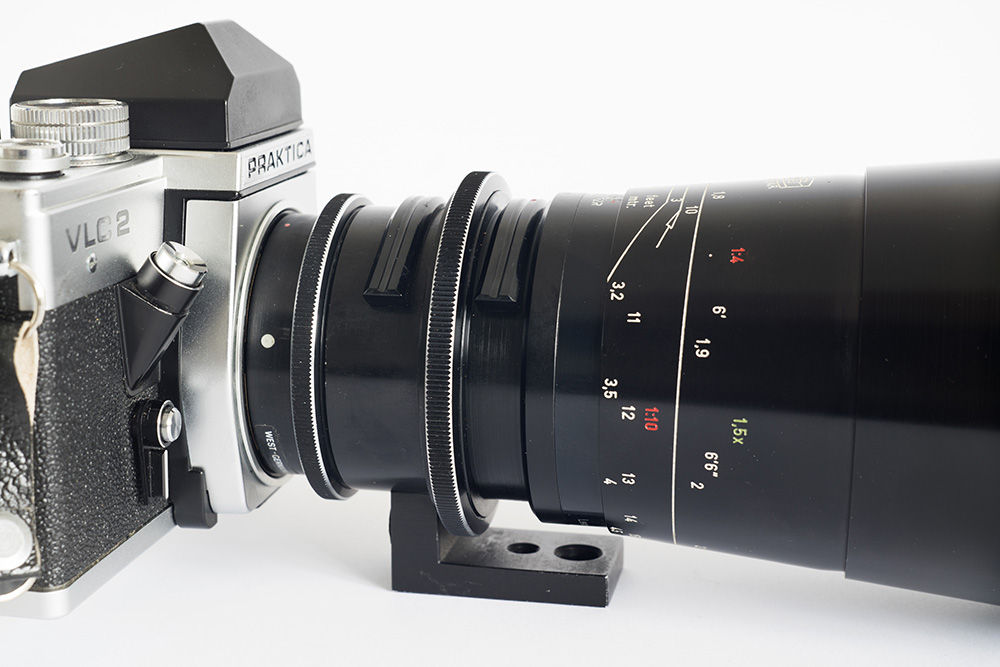 The Pan-Tele Kilar Mk III with a mount for a 35mm camera, in this instance, M42. We note the presence of a tripod platform, although it does not rotate and it is further back on the lens than would be desirable in order to obtain good balance. It has the usual Kilfitt two tripod screw sockets, for ¼" and 3/8". The adapter also has a further slot that could take a second filter. Clicking on this image opens a larger copy. [PTK_III_M42.jpg]
Here are some key statistics on the three versions of the Pan-Tele Kilar:
1 The difference here may merely be due to the thickness of the front cap.
|
||||||||||||||||||||||||||||||||
For information on using the Pan-Tele
Kilar with the Kilfitt Multi-Kilar lens converter, and
results obtained with this combination, see here.
For the results obtained with the Kilfitt
150mm Tele-Kilar used with the Kilfitt Multi-Kilar
variable converter at the 2× setting, see here.
To go on to the next section, click below.
Next section (Zoomar 500mm
Sport-Reflectar)
To go on to the next lens test
section, click below.
Next section
(500-560mm)
To go to the beginning of the lens tests section, click here.
To go to back to the data on Kilfitt lenses, click here.
To choose other options, click below.
Home
© TRA January 2022
